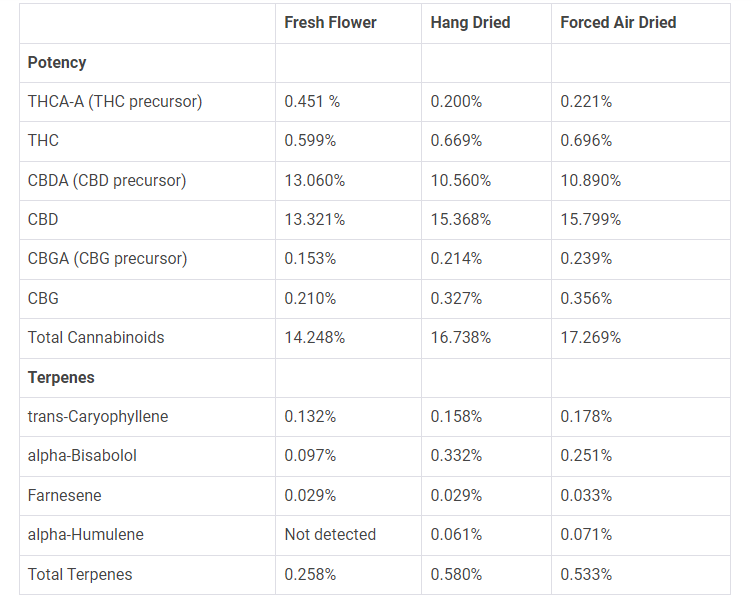Hemp Drying Experiment: Traditional Hang Dry vs. Forced Air Drying
Discover which hemp drying method preserves the most cannabinoids and terpenes
The Debate
Talk to nearly any cultivator or processor. Browse through any online hemp forum. Almost every industry expert swears that traditional, slow hang drying is by far the best method, compared to mechanical trying, to preserve the plant’s precious cannabinoids and terpenes. We’ve heard these claims for years, so we decided to put our preconceived notions to the test–literally.
ACS Laboratory’s Hemp Drying Experiment
Who
We’ve been testing this Florida Hemp Farm’s (FHF) harvest for the last year. We are keeping their name confidential for the purposes of this study.
This extensive South Florida farm conducts both traditional slow hang drying and mechanical forced drying, making it the perfect fit for our experiment.

Arbor Vita8 conducted FHF’s drying process through a forced air method. Here’s how it works: The forced air dryer blows air through 53-foot trailers at 40,000 cubic feet a minute. That means the air inside the unite is replaced six times per minute. This method increases the low humidity airflow at relatively low temperatures using a propane burner to dry the incoming air, ensuring the temperature remains low and never exceeds 80 degrees.


What & How
ACS visited the Farm during harvest for several days, monitoring the process, including cutting, trimming, and drying. All samples came from a unified plot and were clipped and trimmed using the same tools and methods.

After trimming, we placed the hemp flower into three different categories:
- Fresh flower (control group)
- Traditional/slow hang dried flower
- Forced air dried flower
We utilized fresh trimmed hemp as the baseline, or control group, to compare the potency results against the traditional hung dried and forced air-dried samples. To hang dry the hemp, FHF used a mesh drying process inside a temperature-controlled barn. Hang drying takes the farm about seven days.

To machine-dry their hemp, F2F worked with Arbor Vita8’s mobile forced air drying unit. The process took four days because they experimented with both drying and curing the hemp. Typically the process is done in less than two days if the farmer conducts curing separately.



Key Results

Terpenes Analysis
{Quick refresh: Glands on hemp flower buds called trichomes secrete an oily substance containing terpenes. Cannabis contains about 140 terpenes, which are the basis of “essential oils.” Terpenes are essential because they influence the strain’s flavor, fragrance, and therapeutic properties.
- Analysis showed that traditionally hang dried hemp contained the highest overall terpene content marginally. However, the difference was so slight that it would not make a difference from the consumer’s perspective.
- However, when comparing the strain’s most dominant terpenes, we found that forced-air dried flower contained slightly higher percentages of all terpenes except alpha-Bisabolol.
Thoughts and takeaways
Our team was shocked to see that force air dried hemp and traditional hang dried hemp contain essentially the same amount of terpenes. This was a surprise because common wisdom indicates that faster drying methods produce less terpene content. This experiment seems to prove that historical assumption false–at least preliminarily.
We were also surprised initially that fresh, unprocessed flower contained a much lower terpene content than the dried flower. However, when we considered the analysis process, we determined a hypothesis for why this might be: Terpene content is measured as a ratio of the total sample weight, and fresh flower is much heavier than the dried flower. As a result, the test detected lower terpene content.

Cannabinoids and Acidic Pre-Cursors (Potency)
(A quick refresh: In the growing plant, THC, CBD, CBG (and other cannabinoids) exist in acid forms, known as THCA-a, CBDa, and CBGa. Acidic precursors are known to be more potent than cannabinoids and even deliver their own therapeutic benefits when consumed in raw form. Smoking, baking, and other heating processes break the acid forms to produce THC, CBD, and CBG)
- Acidic Cannabinoid Precursors:
- Most acidic precursors, like CBDa, were substantially higher in fresh flower compared to hang dried and forced-air dried hemp. These results made sense because fresh flower has not been processed or exposed to heat yet, which allows its acidic compounds to remain intact.
- The interesting exception was CBGa, known as the mother of cannabinoids, which was most potent in the forced-air dried group.
- Cannabinoids:
- Mechanical forced-air dried hemp contained the highest content of all cannabinoids marginally. However, the difference was so slight that it would not make a difference from the consumer’s perspective.
Thoughts and takeaways:
By being more aware of the differences between acidic precursors like CBDa and cannabinoids, like CBD, R&D innovators might consider creating more of these extracts, Using cold-press processes to preserve acidic compounds, brands can create formulas that deliver potent therapeutic benefits.
COA Results









.png)
.png)
.png)
.png)
.png)